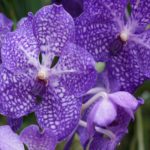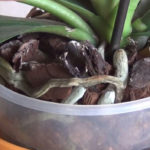Menu
Orchid Care
Information kindly provided by Burnham Nurseries
Many of the tropical species grown in cultivation grow as epiphytes in their natural habitat of the rain forest. This means that they grow up on the branches of the trees where they can benefit from the light, air movement and humidity. We can grow many of these on pieces of cork bark or in baskets, hanging in the greenhouse or conservatory so they can grow in conditions more like their natural environment. Please note that it is not recommended that orchids are grown on bark in the home as they will dry out too often in the less humid atmosphere. Vandas and related genera are often grown in open wooden or plastic baskets with no compost. These too must be grown in a very humid environment to prevent dehydration.
FLOWERING: Many different species of orchids can be grown in this way and will bloom at various times of year when their season comes around. Types with pendent flower spikes grow well hanging in baskets.
TEMPERATURE: Cool species need a minimum of 10°C (50°F) in winter, intermediate a minimum 12°C (55°F) in winter and warm minimum 15°C (60°F) The daytime maximum should be 20-27°C (70-85°F).
LIGHT: Keep all orchids growing on bark in dappled light, shaded from the brightest summer sun. Vanda types need good light to help with their re-flowering.
WATERING: Plants growing in this way need regular watering by spraying, this needs to be done daily during the warmest parts of the year, or even dunk in a bucket for 10 minutes if they are drying out quickly. Add fertiliser to the water during the growing period.
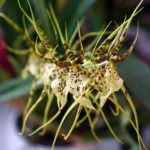
The brassias are commonly known as the ‘Spider Orchids’ due to their spindly flowers. They are very attractive when in bloom with graceful arching spikes of many showy flowers. They come in various shades of green with variable darker markings on the petals and lip. Also the flowers are sweetly scented and they are mostly spring or summer flowering. The plants have dark green leaves and oval pseudobulbs with a compact habit.
RE-FLOWERING: The blooms come from the side of the newly matured pseudobulb. They need fairly good light to help regular blooming which is generally annual in the spring or early summer months.
TEMPERATURE: Intermediate with a minimum 12°C (55°F) in winter, daytime maximum of 30°C (85°F). Will grow best in a humid greenhouse but some will grow well in the home.
LIGHT: To help with re-flowering keep all Brassia types in good light all year round, shaded from the bright summer sun but good light in winter.
WATERING: They like to be moist all the year round as many tend to grow in the in the winter months. They also make copious aerial roots so these will enjoy regular spraying. They are grown in open bark compost and like to be hanging up in a basket or a hanging pot. Re-pot when the plant has outgrown its pot or basket, they don’t mind being a little over the side of the pot, when the new growth is young in the late summer.

The Cattleyas have been bred with many different families such as Laelia and Guarianthe to make many complex hybrids including Laeliocattleya and Cattlianthe. They tend to have large, showy flowers in bright colours with some miniature varieties too. The species are not so common and come from Brazil and other South American countries. They have upright pseudobulbs with thick, leathery leaves.
RE-FLOWERING: The blooms come from inside a sheath produced at the top of the newest mature pseudobulb, at the base of the leaf. They can be singular or several on a head. And are annual flowering usually in spring or autumn.
TEMPERATURE: Intermediate with a minimum 12°C (55°F) in winter, daytime maximum of 30°C (85°F). Will grow best in a humid greenhouse but some will grow well in the home.
LIGHT: To help with re-flowering keep all Cattleya types in good light all year round, shaded from the bright summer sun but good light in winter.
WATERING: They do not like to be too wet so are grown in an open bark compost to ensure good drainage. When in growth in the summer water regularly and spray too, especially aerial roots. In winter, rest with only occasional watering and spraying on sunny days. Re-pot when the plant has outgrown its pot, they don’t mind being a little over the side of the pot, when the new growth is young in the spring or summer.

This is a popular spring flowering species from India that has a beautiful sweet fragrance as well as very pretty white and yellow flowers.
TEMPERATURE: As it is a high altitude plant from the Himalayas, it requires a cool drop in temperature at night in the winter especially. The minimum temperature should be around 8-10°C in winter. Try to keep as cool as possible in the summer.
LIGHT: Keep shaded from the bright summer sun but give as much light as possible during the dull winter months.
WATERING: From the time the new growth begins around February this orchid requires regular watering and misting of the leaves. The flowers are produced first and when they are over the leaves with continue to grow from around the base of the flower stem so do not cut this off. Water and feed once a week all through the summer growing season (imagine the monsoons!) and then in the autumn the new bulbs will have filled out. Continue to water the plant until this state has been reached and all the bulbs are plump then reduce the watering right down for the winter. Occasionally mist the plant over the winter and give a little water if the bulbs start to shrivel.
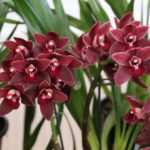
The Cymbidium orchids are ever popular, their showy flowers lasting many weeks. They are best grown in a cool conservatory and placed out of doors in the summer. They are mostly winter and spring flowering although there are also summer and autumn varieties too. Standard varieties grow into large plants with large flowers and bulbs. Miniature or compact types will stay more manageable. A plant should be re-potted in the spring after flowering when it has outgrown its pot, about every 2-3 years.
RE-FLOWERING: Keep these orchids cool and light in winter and outdoors in summer to help re-flowering. Keeping them too warm can prevent blooming.
TEMPERATURE: Cymbidiums need a minimum of 8°C (45°F) in winter to give them a sufficient change in conditions from the warmer summer, when a maximum of 30°C (85°F) is adequate.
LIGHT: Keep shaded form bright, direct summer sun as this can scorch the leaves. Give as much light as possible during the dull winter months.
WATERING: Keep the free-draining bark compost moist with more frequent watering in the spring and summer, the main growing season. When watering the plant, remove it from any cover pot or saucer, pour water through the pot and then let it drain before placing it back in a decorative planter. Never let the pot stand in water. Allow the compost to dry out slightly and the pot to become lighter before watering again. Add a little orchid ‘grow’ fertiliser to the water once every 2 or 3 waterings (approx. every 10-14 days) from February to August and ‘bloom’ fertiliser from August to November.
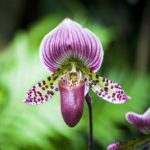
One of the most exotic orchid groups are the ‘Slipper Orchids’ These unusual flowers have a slipper-shaped lip at the front of the flower which, in nature, help the flower become pollinated. In their native countries they are terrestrial, living in the ground or maybe on rocks. They do not have bulbs like other orchids but instead produce shoots that form into a clump. The flowers come from the centre of the newest mature shoot. Paphiopedilums come from the Far East and some have attractive mottled foliage.
RE-FLOWERING: When your slipper orchid has flowered cut the stem right off and the plant will start to grow a new shoot. When this is mature it will produce the next bloom. Some have single flowers; others are multi-flowering.
TEMPERATURE: Most Slipper orchids are warm growing requiring a minimum temperature of 15°C (60°F), with a daytime maximum of 30°C (85°F). Some plain leafed paphiopedilums need a cooler minimum 10°C (50°F).
LIGHT: Keep well shaded from bright, direct summer sun as this can scorch the leaves. Give as much light as possible during the dull winter months.
WATERING: Keep the free-draining bark compost moist all the year round. When watering the plant, remove it from any cover pot or saucer, pour water through the pot and then let it drain before placing it back in a decorative planter. Never let the pot stand in water. Allow the compost to dry out slightly and the pot to become lighter before watering again. Avoid watering collecting in the crown of the plant as this can cause a rot. Add a little orchid fertiliser to the water once every 2 or 3 waterings (approx. every 10-14 days) all year round.
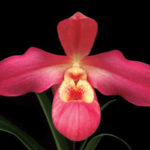
One of the most exotic orchid groups are the ‘Slipper Orchids’ These unusual flowers have a slipper-shaped lip at the front of the flower which, in nature, help the flower become pollinated. The genus Phragmipedium come from South America and in their native countries they are terrestrial, living in the ground, often near to running water. They do not have bulbs like other orchids but instead produce shoots that form into a clump. The flowers come from the centre of the newest mature shoot.
RE-FLOWERING: When your Slipper orchid has flowered cut the stem right off and the plant will start to grow a new shoot. When this is mature it will produce the next bloom. The phragmipediums are sequential flowering, having many flowers one after the other over several weeks.
TEMPERATURE: These Slipper orchids are warm growing requiring a minimum temperature of 15°C (60°F), with a daytime maximum of 30°C (85°F).
LIGHT: Keep well shaded from bright, direct summer sun as this can scorch the leaves. Give as much light as possible during the dull winter months.
WATERING: These orchids are usually potted in rockwool which means that they keep damp more easily than in bark. This is more suited to their way of growing as they like to be kept moist at all times. When watering the plant, remove it from any cover pot or saucer, pour water through the pot and then let it drain before placing it back in a decorative planter. Never let the pot stand in water. Allow the rockwool to dry out only very slightly before watering again. Avoid watering collecting in the crown of the plant as this can cause a rot. Add a little orchid fertiliser to the water once every 2 or 3 waterings (approx. every 10-14 days) all year round. When repotting, always damp the rockwool before use and use gloves to handle it.

One of the most popular orchids grown as houseplants are the Moth Orchids or Phalaenopsis. They make good indoor plants because they can tolerate the drier heat of central heating as well as having extremely long-lasting flowers at any time of year. They do not have bulbs like other orchids but instead grow fleshy leaves, which store food and water with new ones forming from the central crown. They also produce a lot of aerial roots that come over the side of the pot as well as into the bark compost.
TEMPERATURE: Moth Orchids love the warmth of most modern homes, keep a minimum on winter nights of 18°C (65°F), with a daytime maximum of 30°C (85°F).
LIGHT: Keep shaded from bright, direct summer sun as this can scorch the leaves. Give as much light as possible during the dull winter months.
WATERING: Keep the free-draining bark compost moist all the year round. When watering the plant, remove it from any decorative pot or saucer, pour water through the pot and then let it drain before placing it back in a decorative planter. Never let the pot stand in water. Allow the compost to dry out and the pot to become lighter before watering again. Avoid watering collecting in the crown of the plant as this can cause a rot. Add a little orchid fertiliser to the water as directed. Spray the aerial roots regularly with water, trim when they have died off. A Phalaenopsis with many aerial roots is a healthy, happy plant.
